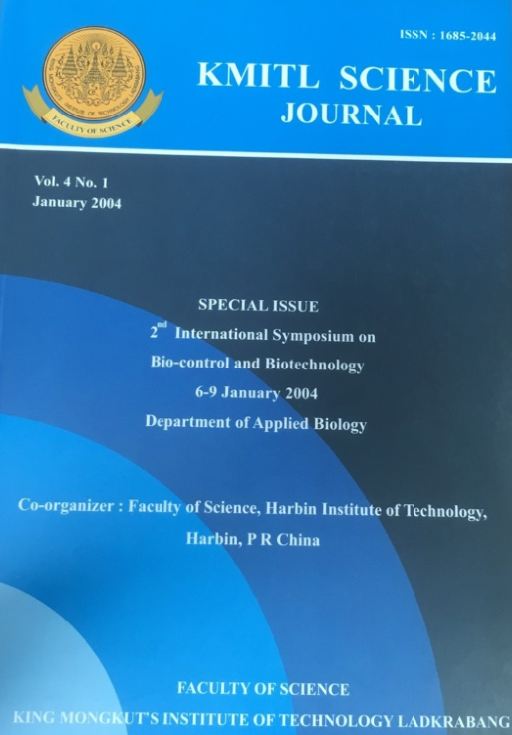Inhibition of Aflatoxin Production and Growth of Aspergillus flavus by Citronell Oil
Main Article Content
Abstract
The activity of citronella oil on aflatoxin production and the growth of Aspergillus flavus was studied. Aspergillus flavus IMI 242684 was grown on PDA and maize grain for 28 days. It was found that the fungal growth on PDA was inhibited by citronella oil at 0.2% (v/v) whereas the growth, aflatoxin production in maize grain were inhibited at 1.0% or more. The growths of A. flavas S 156 on PDA were inhibited by citronella oil at 0.4% whereas the growth of A. parasiticus IMI 10256 was inhibited at 0.2%.
Keywords: aflatoxin, herb, citronella oil, Aspergillus flavus, Aspergillus .parasiticus, aflatoxin producing fungi
Corresponding author: E-mail: cast@kmitl.ac.th
Article Details
Copyright Transfer Statement
The copyright of this article is transferred to Current Applied Science and Technology journal with effect if and when the article is accepted for publication. The copyright transfer covers the exclusive right to reproduce and distribute the article, including reprints, translations, photographic reproductions, electronic form (offline, online) or any other reproductions of similar nature.
The author warrants that this contribution is original and that he/she has full power to make this grant. The author signs for and accepts responsibility for releasing this material on behalf of any and all co-authors.
Here is the link for download: Copyright transfer form.pdf
References
[2] L. Stoloff, Aflatoxins- an overview In Mycotoxins in Humans and Animal Health (J. V. Rodricks, C. W. Hesseltine and M.A. Mehlman, IL: Pathotox Publishers, 1977).
[3] D.M. Wilson and G. A. Payne, Factors affecting Aspergillus flavus group infection and aflatoxin contamination of crops, In The Toxicology of Aflatoxins. Human Health, Veterinary, and Agricultural Significance (David L. Eaton and John D. Groopman, San Diego: Academic Press, 1994).
[4] T. Goto, D. T. Wicklow and Y. Ito, Aflatoxin and cyclopiazonic acid production by a sclerotium producing Aspergillus tamarii strain, Appl. Env. Microbiol. 1996, 4036-4038.
[5] S. W. Peterson, Y. Ito, B. W. Horn and T. Goto, Aspergillus bombycis, a new aflatoxigenic species and genetic variation in its sibling species, A. nomius, Mycologia, 93, 2001, 689-703.
[6] C. P. Kurtzman, B. W. Horn and C.W. Heseltine, Aspergillus nomius, a new aflatoxin producing species related to Aspergillus flavus and Aspergillus tamarii, Antonie Leeuwenhoek, 53, 1987, 147-158.
[7] C. L. Wilson and M. E. Wisniewski, Further alternatives to synthetic fungicides for control of postharvest diseases, In Biological Control of Plant Diseases (E. T. Tjamos: New York: Plenum Press, 1992).
[8] D. Thanaboripat, N. Naranong and N. Peerapakorn, Effect of some herbs on growth of aflatoxin producing fungus, Srinamarinwirot J. Sci., 5, 1989, 33-39.
[9] D. Thanaboripat, K. Nontabenjawan, K. Leesin, D. Teerapiannont, O. Sukchareon and V. Ruangrattanamatee, Inhibitory effects of garlic, clove and carrot on growth of Aspergillus flavus and aflatoxin production, J. Forestry Res, 8, 1997, 39-42.
[10] D. Thanaboripat, W. Cheunoy, U. Petcharat, V. Ruangrattanamatee and K. Kraisintu, Control of aflatoxigenic fungi by Thai neem, GPO J., 21, 2000, 41-49.
[11] A.-L.E. Mahmoud, Antifungal action and antiaflatoxigenic properties of some essential oil constituents, Lett. Appl. Microbiol., 19, 1994, 110-113.
[12] D. Bhatnagar and S.P. McCormick, The inhinitory effect of neem (Azadirachta indica) leaf extracts on aflatoxin synthesis in Aspergillus parasiticus, J. Ass. Off. Chem. Soc., 65, 1988, 1166-1168.
[13] A.A. Ansari and A.K. Shivastava, The effect of eucalyptus oil on growth and aflatoxin production by Aspergillus flavus, Lett. App. Microbiol., 13, 1991, 75-77.
[14] Y. Pomeranz and C. E. Meloan, Food Analysis: Theory and Practice, 3rd ed. (New York: Chapman and Hall, 1994).
[15] R. G. Cuero, J. E. Smith and J. Lacey, Stimulation by Hyphopichia burtonii and Bacillus amyloliquefaciens of aflatoxin production by Aspergillus flavus in irradiated maize and rice grains, Appl. Env. Microbiol. 53, 1987, 1142-1146.
[16] L.M. Seitz and H.E. Mohr, A new method for quantitation of aflatoxin in corn, Cereal Chem, 54, 1977, 179-183.
[17] R. Montes-Belmont and M. Carvajal, Control of Aspergillus flavus in maize with plant essential oils and their components, J. Food Prot., 61, 1998, 616-619.
[18] S. E. Megalla, E.M. El-Keltawi and S. A. Ross, A study of antimicrobial action of some essential oil constituents, Herba Ponica 3, 1980, 181-186.
[19] R. S. Farang, Z. Y. Daw, F.M. Hewedi and G.S.A. El-Baroty, Antimicrobial activity of some Egyptian spice essential oils, J. Food Prot. 52, 1989, 665-667.
[20] A.-L.E. Mahmoud, Inhibition of growth and aflatoxin biosynthesis of Aspergillus flavus by extracts of some Egyptian plants, Lett. Appl. Microbiol., 29, 1999, 334-336.
[21] L.B. Bullerman, F. Y. Lieu and A.S. Seier, Inhibition of growth and aflatoxin production by cinnamon and clove oils, cinnamic aldehyde and eugenol, J. Food Sci. 42, 1977, 1107-1108.
[22] H. Hitokoto, S. Morozumi, T. Wauke, S. Sakai and I. Ueno, Inhibitory effect of spices on growth and toxin production by toxigenic fungi, Appl. Env. Microbiol., 39, 1980, 818-822.
[23] R.L. Buchanan and A.J. Shepard, Inhibition of Aspergillus parasiticus by thymol, J. Food Sci., 46, 1981, 976-977.
[24] A. K. Mishra et al., Antifungal efficacy of essential oil of Cymbopogon martini (lemongrass) against aspergilli, Int. J. Crude Drug Res., 26, 1988, 73-76.
[25] K.K. Sinha, A. K. Sinha and G. Prasad, The effect of clove and cinnamon oils on growth of and aflatoxin production by Aspergillus flavus, Lett. Appl. Microbiol., 16, 1993, 114-117.
[26] P.M. Davidson and M. E. Parish, Methods for testing the efficacy of food antimicrobials, Food Technol., 43, 1989, 148-155.
[27] N. Paster, M. Menasherov, U. Ravid and B. Juven, Antifungal activity of oregano and thyme essential oils applied as fumigants against fungi attacking stored grain, J. Food Prot, 58, 1995, 81-85.
[28] Mei-Chin Yin and Wen-Shen Cheng, Inhibition of Aspergillus niger and Aspergillus flavous by some herbs and spices, J. Food Prot. 61, 1998, 123-125.


